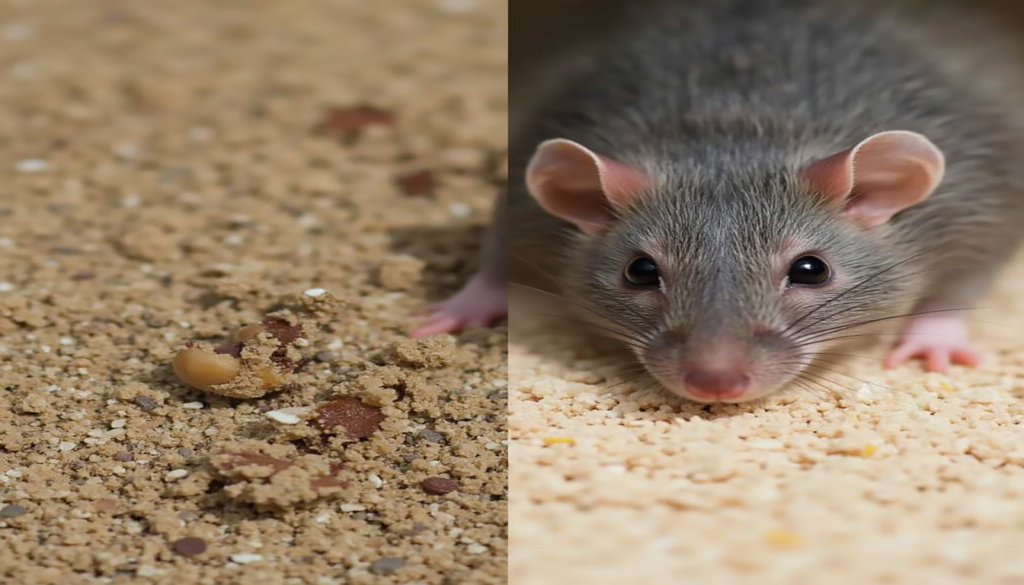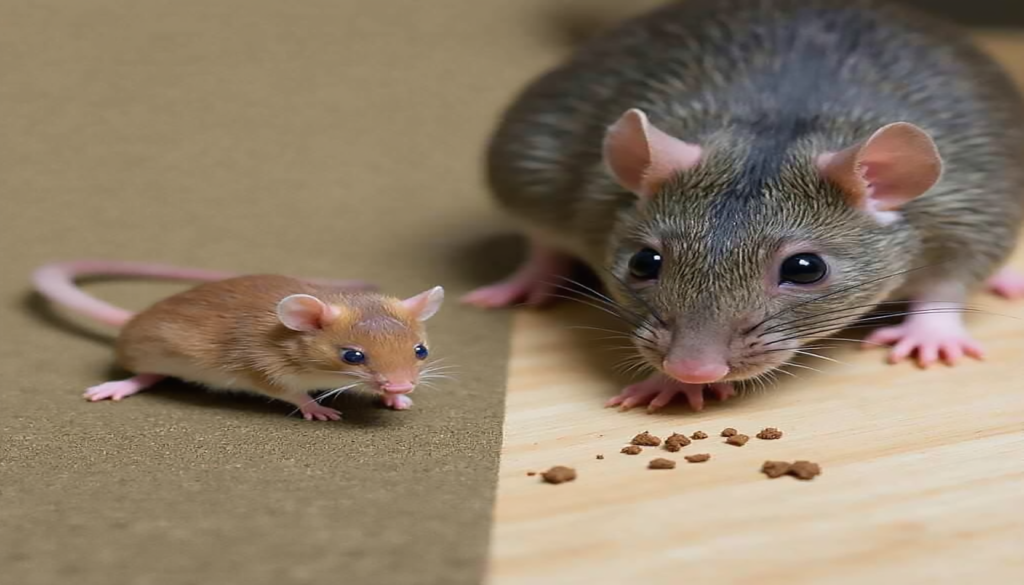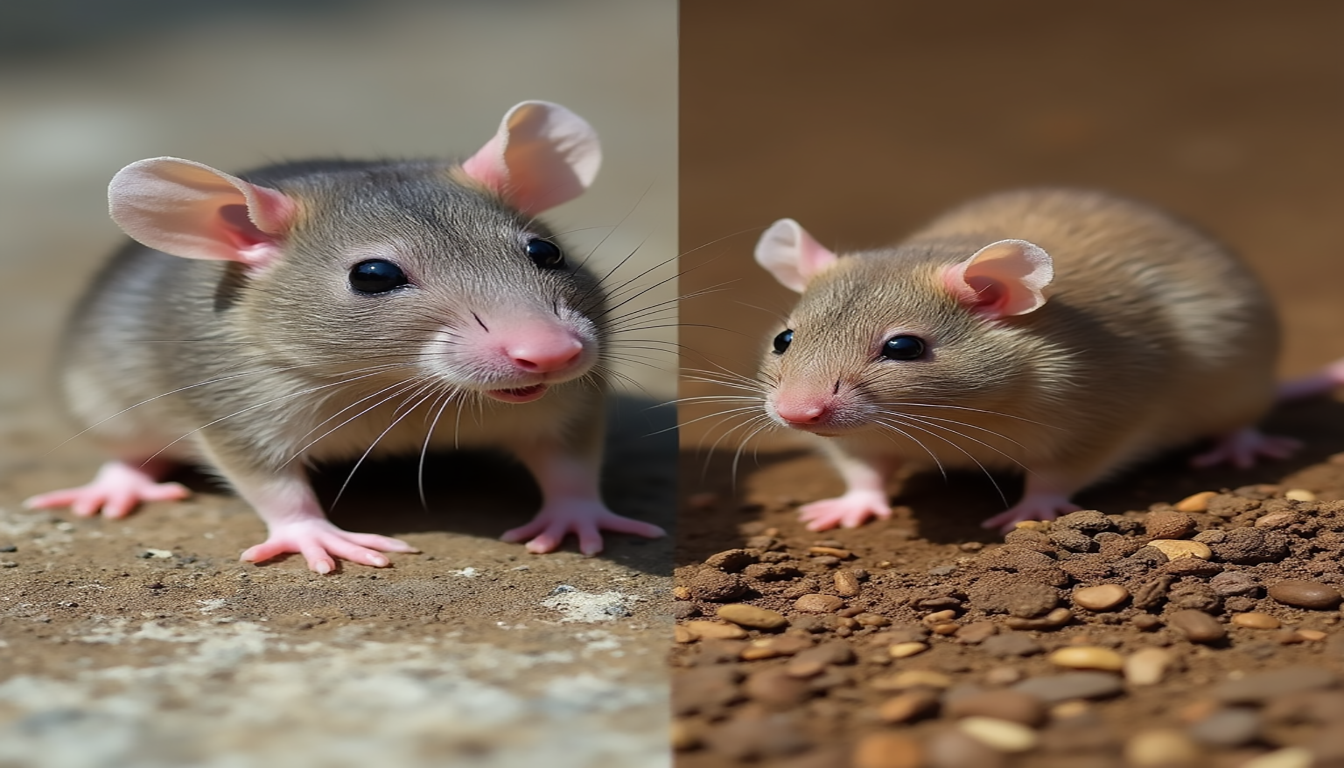
Finding rodent droppings in your home can be scary. It’s important to know how to spot them to keep your home safe. Mice and rats leave clues that can tell you what kind of problem you have.
Rodent droppings look different in size, shape, and color. Each clue tells you about the pest in your home. Knowing these differences helps you fix the problem fast and discover this animal mammal.
Table of Contents
Understanding Rodent Droppings in Your Home
Rodent droppings are key signs of pest problems in homes. Spotting these small signs early can help you fight off rodents. This protects your home and health.
Common Areas Where Droppings Are Found
Rodent droppings can show up in many places in your home. Look closely in:
- Kitchen cabinets and pantries
- Attic spaces
- Basement corners
- Behind appliances
- Inside wall cavities
- Garage storage areas
Why Identifying Droppings Matters
Knowing what rodent droppings look like is vital for pest control. Spotting them correctly helps figure out the rodent type and how bad the problem is. This lets you pick the best way to deal with it.
Initial Signs of Infestation
Look out for more signs of rodents besides droppings:
| Sign | Description |
|---|---|
| Gnaw Marks | Small bite marks on food packaging or wooden surfaces |
| Unusual Sounds | Scratching noises in walls or ceilings, especially at night |
| Nesting Materials | Shredded paper, fabric, or insulation in hidden areas |
| Grease Marks | Dark smudges along walls where rodents frequently travel |
“Early detection is key in preventing a small rodent problem from becoming a serious infestation.”
Mice can leave 50-75 droppings a day. So, checking regularly is important to keep your home rodent-free. Getting help from pest control experts can also help keep your home safe from rodents.
Physical Characteristics of Mouse Droppings
Knowing how to spot mouse feces is key to catching a rodent problem early. It’s important to recognize the signs of rodent excrement to act fast.
Size and Shape Specifics
Mouse droppings are tiny, about 1/8 to 1/4 inch long. They look like grains of rice, making them easy to find. Here’s what to look for:
- Thin, rod-like appearance
- Pointed ends
- Uniform size and shape
Color and Texture Insights
The color and feel of mouse droppings can tell you a lot. Fresh droppings are:
- Dark black or dark brown
- Moist and shiny
- Firm and solid
Fresh vs. Old Droppings
Telling fresh from old droppings helps you understand the mouse problem:
| Fresh Droppings | Old Droppings |
|---|---|
| Soft and moist | Dry and crumbly |
| Darker color | Grayish or faded |
| Shiny surface | Dull and dusty |
Pro Tip: A single mouse can produce 50-80 droppings per day, so even a small number of droppings could indicate a significant infestation.
Spotting mouse droppings early is crucial. It helps you act quickly to keep your home safe and healthy.
Distinctive Features of Rat Droppings
Rat feces have unique features that make them stand out. They are much larger than mouse droppings. Rat droppings can be between 1/2 to 3/4 inches long.
- Roof Rats: Produce droppings with curved, pointed ends around 1/2 inch long
- Norway Rats: Leave rectangular-shaped droppings over 1/2 inch long
Here are some visual features of rat droppings:
| Characteristic | Description |
|---|---|
| Color | Dark brown when fresh, grayish when older |
| Texture | Shiny when fresh, hard and crumbly when dry |
| Shape | Cylindrical with blunt ends |
“Fresh rat droppings are a clear indicator of an active rodent infestation that requires immediate attention.”
Rat feces are often found in clusters. This is different from mouse droppings, which are scattered. Their size and unique look make them easy to spot.
Rat Poop vs Mouse Poop: Key Differences
It’s important to know the differences between rat and mouse droppings to spot pests. By comparing rodent droppings, homeowners can quickly find and fix infestations.
Size Variations that Matter
Size is a key difference in rodent droppings. Mouse droppings are about 1/4 inch long, looking like small rice grains. Rat droppings are bigger, ranging from 1/2 to 3/4 inch long.
| Rodent Type | Droppings Length | Appearance |
|---|---|---|
| Mice | 1/4 inch | Thin, rice-like grains |
| Rats | 1/2 to 3/4 inch | Larger, cylindrical shape |
Shape and End Characteristics
The shape of droppings also helps identify pests. Mouse droppings have pointed ends and are slender. Rat droppings are blunt-ended and look more robust.
Distribution Patterns
Rodent droppings show different behaviors. Mice scatter droppings randomly in small groups as they move. Rats leave droppings in clusters or piles, often near their nests.
- Mice: Scattered, random distribution
- Rats: Clustered, concentrated piles

“Identifying rodent droppings is the first step in understanding and managing potential pest problems in your home.” – Pest Control Expert
Health Risks Associated with Rodent Droppings
Rodent droppings are more than just a mess. They are serious health hazards. These tiny droppings can carry dangerous diseases that spread in many ways.
The main health risks from rodent droppings include:
- Hantavirus Pulmonary Syndrome (HPS)
- Leptospirosis
- Salmonellosis
- Lymphocytic Choriomeningitis (LCMV)
Hantavirus is one of the most dangerous diseases from rodents in the United States. In 2023, 17 cases of HPS were reported in western states. New Mexico had 7 cases, with 2 deaths. The virus spreads when you breathe in particles from rodent droppings, urine, or saliva.
“The risk of infection increases significantly when cleaning areas with potential rodent activity” – CDC Rodent Control Guidelines
Symptoms of these diseases can range from mild to severe. Hantavirus symptoms start 1-8 weeks after exposure. They can include:
- Fever
- Muscle aches
- Headaches
- Difficulty breathing
To stay safe, always wear protective gloves when cleaning areas with rodents. Make sure spaces are well-ventilated before cleaning. Avoid sweeping or vacuuming droppings directly. If you think there’s a big problem, call professional pest control right away.
Safe Cleaning and Disposal Methods
Dealing with rodent droppings needs careful attention to cleaning and sanitation. It’s important to protect your health to avoid disease.
Essential Protective Equipment
Before you start cleaning, make sure you have the right gear:
- Disposable gloves (preferably rubber or latex)
- N95 respirator mask
- Protective eyewear
- Disposable coveralls or old clothing you can immediately wash

Proper Cleaning Techniques
Here are the key steps for cleaning rodent droppings:
- Ventilate the area by opening windows for 30 minutes
- Create a disinfectant solution (1 part bleach to 9 parts water)
- Wet down droppings to minimize dust
- Use disposable paper towels to carefully remove droppings
- Disinfect the entire area thoroughly
Disposal Guidelines
Proper disposal is key for effective rodent waste removal:
| Item Type | Disposal Method |
|---|---|
| Contaminated Materials | Seal in plastic bags, double-bag, and dispose in outdoor trash |
| Used Cleaning Materials | Place in sealed plastic bag and discard immediately |
| Personal Protective Equipment | Dispose of single-use items; wash reusable items in hot water |
“Always prioritize your health and safety when dealing with rodent waste.” – Public Health Expert
Remember to wash your hands thoroughly with soap and warm water after completing the cleanup process. If soap is unavailable, use an alcohol-based hand sanitizer.
Preventing Rodent Infestations
To keep your home rodent-free, you need to act early. Knowing the risks and taking steps can help a lot. This way, you can avoid unwanted visitors.
Stopping rodents starts with finding and fixing entry points. They can fit through tiny openings. So, it’s important to check your home well.
- Seal cracks and gaps in foundations
- Install door sweeps on exterior doors
- Check window screens for damage
- Repair holes around utility lines
Managing food is key to keeping pests away. Rodents love easy food, so keep your kitchen and storage clean.
“Prevention is always easier than elimination when it comes to rodent control.” – Pest Control Expert
Here’s how to store food right:
- Use airtight containers for dry goods
- Clean up spills immediately
- Store pet food in sealed containers
- Keep trash in rodent-proof bins
Keeping your yard tidy helps too. A clean yard is less welcoming to rodents.
| Prevention Area | Key Actions |
|---|---|
| Landscaping | Remove debris, trim vegetation away from house |
| Food Management | Secure food, clean regularly |
| Home Maintenance | Seal entry points, repair damages |
Stay alert to keep rodents away. Regular checks and quick action can prevent big problems.
Common Areas of Rodent Activity
It’s important to know where rodents like to be to keep your home safe. Rodents look for places that are warm, have food, and are hidden. They can be found inside and outside your home.
Indoor Hotspots for Rodent Activity
Rodents like certain spots inside your home. These places offer them safety and food. Some common spots include:
- Kitchen cabinets and pantries
- Basement storage areas
- Attic spaces with insulation
- Wall cavities near food sources
- Garage storage shelves
Outdoor Locations That Attract Rodents
Outdoor areas can also attract rodents. Look out for these spots:
- Wood piles near home foundations
- Dense garden vegetation
- Compost heaps
- Outdoor trash containers
- Unmaintained landscaping
Critical Entry Points to Monitor
Rodents can fit into tiny openings. Check these spots to keep them out:
- Gaps around utility pipes
- Cracks in foundation walls
- Damaged window screens
- Unsealed door thresholds
- Roof and attic ventilation openings
“Prevention is always more effective than dealing with an established rodent problem.”
Professional Pest Control Options
When DIY methods can’t handle your rodent problem, it’s time to call the pros. Pest management experts have the tools and knowledge to tackle rodent infestations head-on.
Professional pest control goes beyond simple traps. They offer:
- Comprehensive property inspections
- Targeted treatment plans
- Advanced exclusion techniques
- Long-term prevention strategies
Choosing the right pest management pro is key. Look for certified technicians with a history of success in rodent control. They know how rodents behave and can spot entry points you might miss.
“Effective rodent control is about understanding the problem, not just treating its symptoms.” – Pest Control Expert
Experts use a variety of methods, including:
- Strategic trap placement
- Specialized bait stations
- Structural repair recommendations
- Ongoing monitoring
Professional help saves time, reduces health risks, and prevents damage. Investing in quality pest management now can save you money in the long run.
Natural Deterrents and Prevention Strategies
Keeping your home rodent-free doesn’t need harsh chemicals. Eco-friendly pest control offers natural ways to keep rats and mice away. Learning about these natural repellents can help you keep your home safe and pest-free.
Essential oils are strong natural deterrents. Rats don’t like the strong smells of:
- Peppermint oil
- Eucalyptus oil
- Citronella
- Tea tree oil
Home maintenance is key to preventing rodents. Sealing all entry points is a big part of eco-friendly pest control.
| Prevention Strategy | Effectiveness Rating |
|---|---|
| Sealing gaps around pipes | High |
| Using steel wool for blocking entries | Very High |
| Trimming vegetation near home | Moderate |
| Storing food in airtight containers | High |
Using natural repellents means being consistent. Always check your home for entry points and keep it clean to stop rodents.
“Prevention is always better than cure when it comes to managing rodent populations.” – Pest Control Expert
Natural methods work well, but big infestations might need a pro. Using eco-friendly pest control can greatly lower the chance of rodent problems.
Conclusion
Knowing the difference between rat and mouse droppings is key to managing pests. Spotting and acting on rodent signs can keep your home safe and sound. Remember, even a few droppings can mean a big problem is coming.
Effective pest control needs a smart plan. Knowing how mice and rats breed and get into homes helps you fight them better. Always wear protective gear, keep things clean, and act fast to stop rodents.
Every step you take helps. Sealing holes, keeping things tidy, or calling pros when needed all help. Rodents can spread diseases like hantavirus and leptospirosis, so catching them early is crucial.
With the tips from this guide, you can tackle rodent problems head-on. Stay alert, ready, and keep your home rodent-free.
FAQ
How can I tell the difference between rat and mouse droppings?
Look at the size and shape. Mouse droppings are small, about 1/4 inch, and pointy, like rice grains. Rat droppings are bigger, about 3/4 inch, and round, like raisins. Rat droppings also cluster more, while mouse droppings are scattered.
Are rodent droppings dangerous to my health?
Yes, they are very dangerous. They can spread diseases like Hantavirus, Salmonellosis, and Leptospirosis. These diseases can get into your body through touch, breathing in dust, or touching food and surfaces. Always wear protective gear when cleaning and avoid making dust when handling rodent waste.
Where are rodents most likely to leave droppings in my home?
Rodents leave droppings where they find food and shelter. This includes kitchens, pantries, attics, basements, and storage areas. Look for them behind appliances, inside cabinets, near food, along baseboards, and in dark spots.
How can I prevent rodent infestations?
To prevent rodents, seal entry points, store food in tight containers, keep your home clean, and remove outdoor attractants. Also, check your property for signs of rodents. Keeping your home and surroundings clean and sealed helps prevent rodents.
What protective equipment do I need when cleaning rodent droppings?
Wear disposable gloves, an N95 respirator mask, protective eyewear, and long-sleeved clothing. Don’t sweep or vacuum, as it can spread particles. Use disinfectant solutions and paper towels to clean.
When should I call a professional pest control service?
Call a professional if you see a lot of droppings, many entry points, or if DIY methods don’t work. They can do thorough inspections, targeted treatments, and create plans to keep rodents away.
Are there natural ways to deter rodents?
Yes, use peppermint oil, citrus scents, ultrasonic devices, and keep your home clean. Plant mint, use essential oil sprays, and make sure no food is out. But, these methods might not work as well as professional pest control for big problems.
How do I distinguish between fresh and old rodent droppings?
Fresh droppings are dark, moist, and shiny. Old droppings are dry, grayish, and crumbly. Fresh droppings mean rodents are active, while old droppings might mean they were before. The look and where you find them can tell you about rodent activity.

